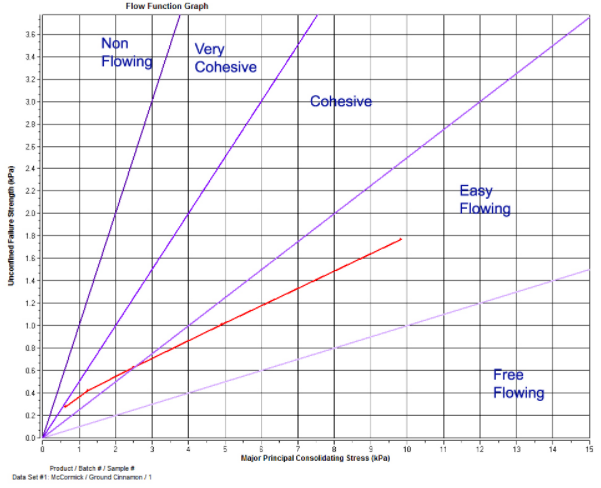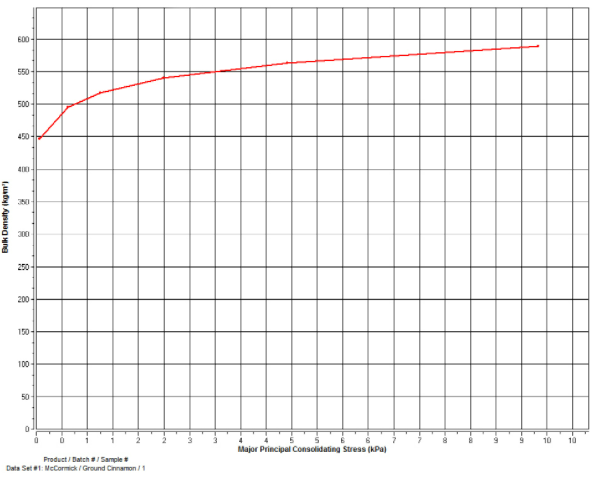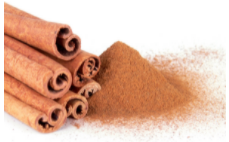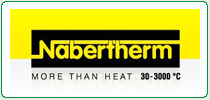USE
Determination of powder flow characteristics of ground cinnamon.
TEST EQUIPMENT
Instrument: Powder Flow Tester (PFT)
Trough: 230 cc, 6-inch diameter (Standard Volume)
Lid Type: Vane Lid, 33cc, 6-inch diameter
Wall Lid, 2B finish, 6-inch diameter
Type of Test: Flow Function Test
Temperature: Room Temperature (70-72°F)
Humidity: 48%
METHOD
A Brookfield Powder Flow Tester equipped with Powder Flow Pro software for automated instrument control and data acquisition, was used to test ground cinnamon. The cinnamon was scooped into the trough, and the scraping tool was then used to evenly distribute the powder and form the sample. After recording the sample weight and entering it into the software, a standard flow function test was run. Time required for the test was 25 minutes.
PARAMETERS MEASURED
Flowability: Easy Flowing/Cohesive
Bulk Density: 446 kg/m3 (fill density) to 589 kg/m3 (final bulk density)
ANALYSIS
Hopper Shape: Conical
Critical Arching Dimension: 0.085 m (85 mm; 3.3 in.)
Rat-hole Diameter: 0.864 m (Bin diameter 2 m)
RESULTS
Figure 1 shows the flowability of the ground cinnamon at different levels of consolidating stress. These results show that the cinnamon is easy flowing at higher consolidating stresses and then becomes more cohesive and difficult to flow at lower consolidating stresses.
Note: The Flow Function data is indicated by the red line. The other lines are references (or “Standard Flow Indices”), which distinguish the different types of flow behavior, ranging from “non-flowing” to “free flowing”.
The axes are Unconfined Failure Strength (kPa) vs. Major Principle Consolidating Stress (kPa).

Figure 1: Ground Cinnamon Flow Function Graph
|
Data Set (#) |
Arching Dimensions (m) |
Rat-hole Diameter (m) |
|
1 |
0085 |
0.864 |
Figure 2: Arching Dimensions and Rat-hole Diameter
Figure 2 shows arching dimension and rat-hole diameter (based on a standard bin diameter of 2 meters and a bin height of 8 meters). An opening of greater than 0.085m is required to ensure a cohesive arch does not form. An opening of greater than 0.864 m is required to ensure a rat-hole will not form. These values indicate a material that may have flowing issues.

Figure 3: Ground Cinnamon Bulk Density Graph
Figure 3 shows the bulk density of the material at different levels of consolidating stress. This graph tells us that the ground cinnamon has a fill density of about 446 kg/m³ and rises to about 589 kg/m³ at around 9.6 kPa of consolidating stress. In general, a free flowing powder will show very small changes in bulk density, while a cohesive or poor flowing powder will generally show a large increase (30% to 50%) in bulk density. This cinnamon shows an increase of 32% in bulk density which is an indicator that this powder may have an issue flowing.
The axes are Bulk Density (kg/m3) vs. Major Principle Consolidating Stress (kPa).
CONCLUSION
The ground cinnamon starts out easy flowing when the feeder system is full, then it becomes cohesive at the lower consolidating stresses as the system is emptying. Possible problems include cohesive arching (when the powder forms a cohesive bridge over the outlet) and rat-holing (when the powder flows out only from the center leaving the rest of the material static against the walls). This material flows like many spices do in that they start as an easy flowing material and then gain strength, becoming more cohesive as the system is emptying. Cinnamon, being a spice, will also be hygroscopic, so high humidity levels will make this material become even harder to flow.
>>Download a pdf of this application note.
Contact us : This email address is being protected from spambots. You need JavaScript enabled to view it.

















